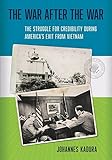The War after the War : The Struggle for Credibility during America's Exit from Vietnam / Johannes Kadura.
Material type: TextPublisher: Ithaca, NY : Cornell University Press, [2016]Copyright date: ©2016Description: 1 online resource (248 p.) : 5 halftones, 2 mapsContent type:
TextPublisher: Ithaca, NY : Cornell University Press, [2016]Copyright date: ©2016Description: 1 online resource (248 p.) : 5 halftones, 2 mapsContent type: - 9781501703799
- 959.704/310973 23
- DS559.62.U6 K33 2016
- online - DeGruyter
| Item type | Current library | Call number | URL | Status | Notes | Barcode | |
|---|---|---|---|---|---|---|---|
 eBook
eBook
|
Biblioteca "Angelicum" Pont. Univ. S.Tommaso d'Aquino Nuvola online | online - DeGruyter (Browse shelf(Opens below)) | Online access | Not for loan (Accesso limitato) | Accesso per gli utenti autorizzati / Access for authorized users | (dgr)9781501703799 |
Browsing Biblioteca "Angelicum" Pont. Univ. S.Tommaso d'Aquino shelves, Shelving location: Nuvola online Close shelf browser (Hides shelf browser)

|

|

|

|

|

|

|
||
| online - DeGruyter Before the Gregorian Reform : The Latin Church at the Turn of the First Millennium / | online - DeGruyter Varietals of Capitalism : A Political Economy of the Changing Wine Industry / | online - DeGruyter From Convergence to Crisis : Labor Markets and the Instability of the Euro / | online - DeGruyter The War after the War : The Struggle for Credibility during America's Exit from Vietnam / | online - DeGruyter Petrarchism at Work : Contextual Economies in the Age of Shakespeare / | online - DeGruyter The Statebuilder's Dilemma : On the Limits of Foreign Intervention / | online - DeGruyter Hoping to Help : The Promises and Pitfalls of Global Health Volunteering / |
Frontmatter -- Contents -- Acknowledgments -- Abbreviations in the Text -- Introduction: Contingency Planning in Turbulent Times -- 1. The Strategy of the Cease-fire -- 2. The X Plus 60 Period -- 3. The Collapse of the Equilibrium Strategy -- 4. Going Down with Colors Flying -- 5. Ford and the Fall of Saigon -- 6. Beyond Defeat in Indochina -- Conclusion: A Mixed Record -- Notes -- Bibliographic Essay on the Different Interpretations of the Post–Paris Agreement Period -- Bibliography of Primary Sources -- Index
restricted access online access with authorization star
http://purl.org/coar/access_right/c_16ec
In The War after the War, Johannes Kadura offers a fresh interpretation of American strategy in the wake of the cease-fire that began in Vietnam on January 28, 1973. The U.S. exit from Vietnam continues to be important in discussions of present-day U.S. foreign policy, so it is crucial that it be interpreted correctly. In challenging the prevailing version of the history of the events, Kadura provides interesting correctives to the different accounts, including the ones of the key actors themselves, President Richard Nixon and Secretary of State Henry Kissinger foremost among them. In so doing, Kadura aims to forge a synthesis between orthodox and revisionist interpretations of this important period.Kadura finds that the strategy employed by Nixon and Kissinger centered on the concepts of "equilibrium strategy" and "insurance policy." That approach allowed them to follow a twofold strategy of making a major effort to uphold South Vietnam while at the same time maintaining a fallback strategy of downplaying the overall significance of Vietnam. Whether they won or lost on their primary bet to secure South Vietnam, Nixon and Kissinger expected to come through the crisis in a viable strategic position.
Mode of access: Internet via World Wide Web.
In English.
Description based on online resource; title from PDF title page (publisher's Web site, viewed 26. Apr 2024)


